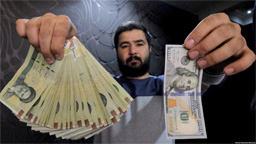FARAH CITY (Pajhwok Afghan News) — A number of residents of western Farah province have suffered losses as a result of a drop in the Iranian rial’s value. However, according to Pajhwok news agency, importing goods remained unaffected as they have converted tomans into dollars and strike business deals in the US currency.

- A moneychanger poses for the camera with a U.S dollar bill and the amount being given when converting it into Iranian rials at Tehran’s business district, January 20, 2016.
(Photo: Courtesy of Radio Farda)
Iran’s government is scrambling to contain a currency crisis after the rial hit an all-time low, prompting panic-buying of hard-to-find dollars amid political uncertainty. The Iranian currency has been steadily losing its value against the dollar since the 1979 Islamic revolution, when one dollar bought 70 rials.
Most of transactions in Farah, Nimroz and Herat provinces are made in the Iranian rial. In March, 10,000 rials acounted for 17.5 afghanis but today 10,000 Iranian rials are equal to nine afghanis.
Abdur Rahman, a resident of Farah City, told Pajhwok that he had converted 720,000 afghanis into the Iranian currency three months back when 10,000 rials accounted for 16 afghanis. He converted the currency, hoping the value of the Iranian rial would soar. Unfortunately, the rial has been in a free fall since renewed US sanctions on Iran. He claimed suffering a 270,000 afs loss.
Many other Farah residents suffered similar losses as a result of the Iranian currency’s fall.
At the present, Iranian exporters sell their products to Afghan traders for US dollars. Nevertheless, wholesalers sell their goods for rial as deals in the Iranian currency were a common practice in Farah. This has harmed wholesalers.
Mariam Faizi, a lecturer at the Ghurjistan University in Farah, called the government’s monetary policy on the use of foreign currencies such as the Pakistani rupee in the eastern part of the country and rial in western Afghanistan a matter of concern. She asked the government to develop a programme for the prevention of transactions in foreign currencies and promote the use of the afghani all over the country.
Meanwhile in Iran, Saeed Laylaz, an economist close to the President Rouhani team, said both internal and external political reasons were driving the currency devaluation. Some officials have blamed Iran’s regional rivals, including US-backed Saudi Arabia and the UAE, for limiting Tehran’s access to dollars. Laylaz told the Guardian:
In the past 20 years, we have consistently been having hard currency surplus, even under Mahmoud Ahmadinejad […] so you have to look for domestic and international political reasons to understand this.
[…]
We’re not facing a currency crisis, we’re facing a crisis in accessing currency notes, and there’s a big difference. If you want to access currency in the form of LCs [letters of credit], no matter [whether] you’re in the private or public sector, you can get it.

